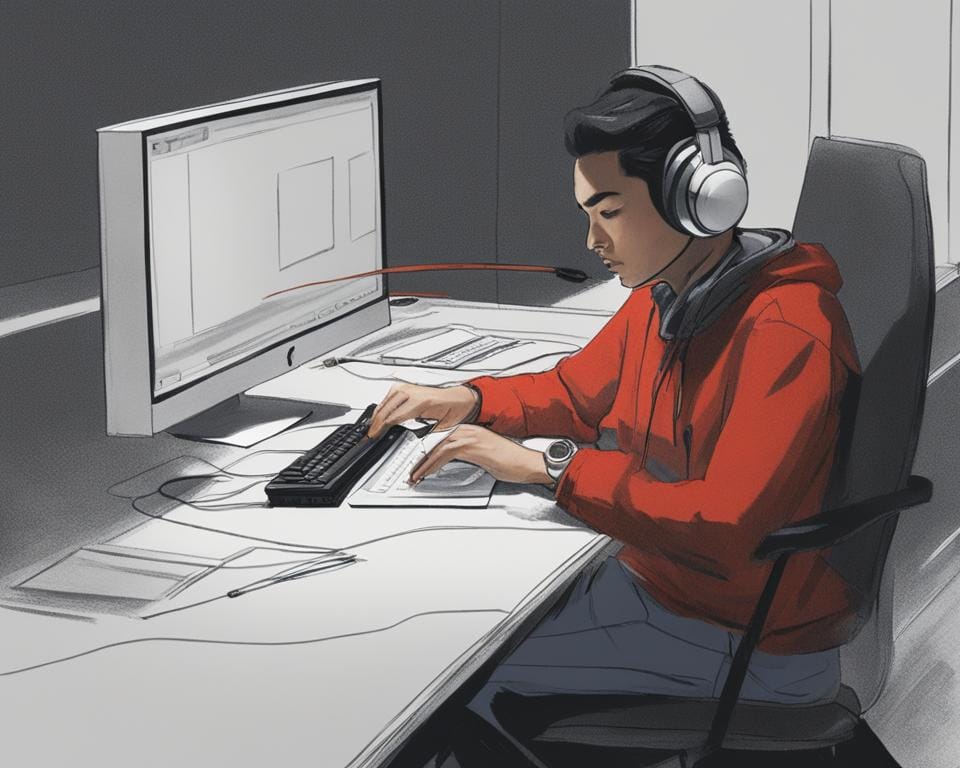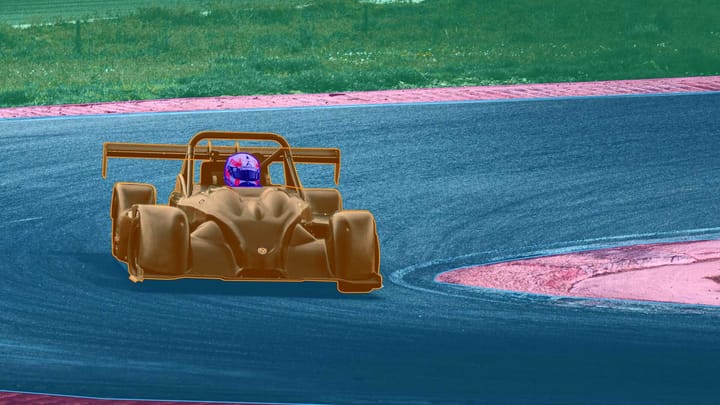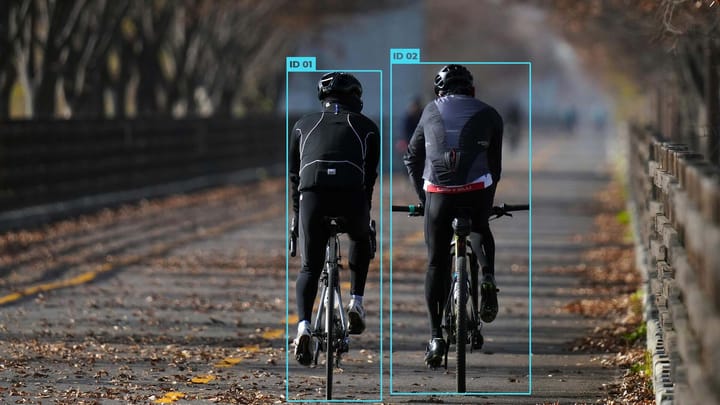Fundamentals of Tight Bounding Boxes in Image Annotation

A person in front of a computer, using a mouse to draw a tight bounding box around an object in an image. The person has a focused expression and is wearing headphones. The image on the computer screen is blurry and out of focus, making it difficult to discern the object being annotated.
Bounding box annotation is a fundamental and basic type of image annotation used in computer vision and machine learning applications. It involves drawing a rectangle around a specific object or feature of interest in an image and labeling it with a class label. Bounding boxes are important for object detection, image annotation, data visualization, and object recognition.
There are different types of bounding boxes, including axis-aligned bounding boxes, minimum bounding boxes, rotated bounding boxes, oriented bounding boxes, minimum volume bounding boxes, and convex hull bounding boxes.
Understanding the fundamentals of tight bounding boxes in image annotation is essential for accurate and efficient annotation. In this article, we will explore why bounding boxes are important, the different types of bounding boxes, best practices for bounding box annotation, and tricks to improve efficiency and accuracy.
Key Takeaways:
- Bounding boxes are crucial for object detection, image annotation, data visualization, and object recognition.
- Types of bounding boxes include axis-aligned bounding boxes, minimum bounding boxes, rotated bounding boxes, oriented bounding boxes, minimum volume bounding boxes, and convex hull bounding boxes.
- Best practices for bounding box annotation include ensuring tightness, intersection over union, pixel-perfect tightness, avoiding or reducing overlap, annotating diagonal objects using polygons or instance segmentation, labeling and tagging names, considering box size, and annotating occluded objects.
- Tricks to improve efficiency and accuracy in bounding box annotation include using appropriate tools, keyboard shortcuts, templates, artificial intelligence, and maintaining a consistent approach.
- Understanding the fundamentals and implementing best practices and tricks can optimize the workflow and achieve improved results in image annotation tasks.
Why Are Bounding Boxes Important in Image Annotation?
Image annotation plays a significant role in various computer vision tasks, and bounding boxes are essential components of this process. Bounding boxes provide crucial information for object detection, image annotation, data visualization, and object recognition. They allow for the identification and localization of objects in an image or video, enabling computer systems to understand and analyze visual data more effectively. By drawing a rectangle around a specific object or feature of interest, annotators can label it with a corresponding class, providing valuable insights for machine learning algorithms and image databases.
Bounding boxes also contribute to data visualization by highlighting specific features or patterns in an image. They offer a visual representation of objects and their positions, allowing for clear and concise communication of information to users or stakeholders. Additionally, bounding boxes facilitate object recognition by comparing the shape and position of the bounding box with a database of known objects. This comparison enables systems to classify and identify objects based on their visual characteristics, contributing to tasks such as image categorization and scene understanding.
Overall, bounding boxes are indispensable tools in image annotation. They enable accurate object detection, provide valuable insights for data analysis and visualization, and support robust object recognition. By incorporating bounding boxes into the image annotation workflow, practitioners can enhance the efficiency and effectiveness of computer vision tasks, leading to improved results and meaningful insights.
The Importance of Bounding Boxes in Image Annotation:
- Enable object detection and localization
- Provide valuable insights for data analysis and visualization
- Facilitate object recognition and classification
Types of Bounding Boxes in Image Annotation
Bounding box annotation in image annotation involves the use of different types of bounding boxes to accurately enclose specific objects or features of interest. These bounding boxes serve as essential tools in computer vision and machine learning tasks. Let's explore the various types of bounding boxes commonly used in image annotation:
Axis-aligned Bounding Boxes (AABBs)
Axis-aligned bounding boxes are aligned with the x and y axes of the coordinate system. They are widely used in 2D computer graphics and provide a simple and efficient way to enclose objects. AABBs are quick to compute and easy to work with, making them a popular choice in many applications.
Minimum Bounding Boxes (MBBs)
Minimum bounding boxes are designed to enclose objects with the minimum possible area. They are especially useful for object recognition and image compression tasks. MBBs provide a tight fit around the object and help reduce unnecessary background noise, improving the accuracy of subsequent processing steps.
Rotated Bounding Boxes
Unlike axis-aligned bounding boxes, rotated bounding boxes can be rotated to better fit non-horizontally or non-vertically oriented objects. These bounding boxes are beneficial when annotating objects that have a specific tilt, such as vehicles on a curved road or objects at different angles.
Other types of bounding boxes used in image annotation include oriented bounding boxes (OBBs), minimum volume bounding boxes, and convex hull bounding boxes. Each type has its own advantages and applications depending on the characteristics of the objects being annotated.
| Type of Bounding Box | Application |
|---|---|
| Axis-aligned Bounding Boxes (AABBs) | 2D computer graphics, general object annotation |
| Minimum Bounding Boxes (MBBs) | Object recognition, image compression |
| Rotated Bounding Boxes | Non-horizontal or non-vertical object annotation |
| Oriented Bounding Boxes (OBBs) | Complex-shaped objects annotation |
| Minimum Volume Bounding Boxes | Object recognition, space optimization |
| Convex Hull Bounding Boxes | Objects with irregular shapes annotation |
Best Practices for Bounding Box Annotation in Image Annotation
Bounding box annotation is a crucial task in image annotation, and following best practices can significantly enhance the accuracy and quality of the annotations. Implementing these practices ensures precise and consistent bounding box annotations, leading to improved object detection and recognition. Here are some key best practices:
Tightness and Accuracy
Ensuring tightness in bounding box annotations is essential for accurately defining the boundaries of objects. It is important to carefully adjust the size and shape of the bounding box to tightly enclose the object of interest. This helps reduce ambiguity and provides more precise information for computer vision algorithms.
Intersection over Union (IoU)
Intersection over Union (IoU) is a measure of the overlap between the annotated bounding box and the ground truth bounding box. Aim for a high IoU to ensure accurate annotations. By aligning the bounding box with the ground truth as closely as possible, you can minimize potential errors and improve the overall accuracy of the annotations.
Avoiding or Reducing Overlap
In cases where multiple objects are present in an image, it is important to avoid or reduce overlap between bounding boxes. This can help prevent confusion and make it easier for computer vision algorithms to detect and differentiate between individual objects. Adjusting the bounding boxes to avoid overlap enhances the accuracy of the annotations.
Annotating Diagonal Objects and Occluded Objects
When dealing with diagonal objects or objects that are partially occluded, it is advisable to use polygons or instance segmentation instead of traditional rectangular bounding boxes. This ensures that the annotations accurately represent the shape and location of the object, even in challenging scenarios. Pay attention to visible portions of occluded objects and annotate based on their visibility to provide accurate information.
Labeling and Tagging
Assigning appropriate labels and tags to bounding boxes is crucial for effective object recognition. Use clear and descriptive names to label objects accurately, facilitating future analysis and training of machine learning models. Consistency in labeling and tagging also contributes to the overall quality of the annotated dataset.
Consideration of Box Size
Box size should vary according to the size of the object being annotated. Annotating objects with appropriately sized bounding boxes ensures that the annotations accurately represent the object's proportions. Avoid excessively large or small bounding boxes as they can negatively impact the accuracy of subsequent object detection and recognition tasks.
| Best Practices | Description |
|---|---|
| Tightness and Accuracy | Adjust the size and shape of the bounding box to tightly enclose the object of interest, ensuring precise boundaries. |
| Intersection over Union (IoU) | Aim for a high IoU by aligning the bounding box with the ground truth to improve accuracy. |
| Avoiding or Reducing Overlap | Adjust bounding boxes to avoid or reduce overlap between objects, enhancing detection and differentiation. |
| Annotating Diagonal Objects and Occluded Objects | Use polygons or instance segmentation for diagonal objects or objects that are partially occluded to accurately represent their shape and location. |
| Labeling and Tagging | Assign clear and descriptive names to bounding boxes for accurate object recognition and analysis. |
| Consideration of Box Size | Vary the size of bounding boxes according to the object's size to accurately represent its proportions. |
Tricks to Improve Efficiency and Accuracy in Bounding Box Annotation
Bounding box annotation is an essential task in image annotation, and employing efficient techniques can significantly improve accuracy and productivity. Here are some valuable tricks to enhance the efficiency and precision of bounding box annotation:
Use the Right Tools
Choosing the appropriate annotation tools is crucial for streamlining the annotation process. Look for tools that provide intuitive interfaces, easy-to-use drawing tools, and efficient labeling features. Utilizing tools that offer keyboard shortcuts can further expedite the annotation workflow.
Create and Utilize Templates
To save time when annotating similar objects across multiple images, consider creating templates. Templates allow you to pre-define the shape and size of bounding boxes, making it easier to annotate consistent objects quickly. By reusing templates, you can maintain annotation consistency while increasing efficiency.
Leverage Artificial Intelligence
Artificial intelligence-powered annotation tools can automate parts of the annotation process, reducing manual effort and increasing annotation speed. These tools often utilize machine learning algorithms to predict bounding boxes based on existing annotations, providing initial suggestions that can be refined by human annotators. By leveraging AI, you can accelerate the annotation workflow while maintaining accuracy.
Adopt a Consistent Approach
Maintaining a consistent approach in drawing bounding boxes and labeling objects is essential for ensuring annotation accuracy. Establish clear guidelines and standards for annotation, and communicate them effectively to all annotators. Consistency contributes to better training data quality and minimizes errors in subsequent computer vision tasks.
By implementing these tricks, data annotators and computer vision practitioners can significantly enhance the efficiency and accuracy of bounding box annotation. These techniques, coupled with best practices and a deep understanding of image annotation fundamentals, can optimize the workflow and improve results in various computer vision applications.
| Trick | Description |
|---|---|
| Use the Right Tools | Choose annotation tools with user-friendly interfaces and keyboard shortcuts for faster and smoother annotation. |
| Create and Utilize Templates | Save time by creating templates to quickly annotate similar objects across multiple images, ensuring consistency. |
| Leverage Artificial Intelligence | Make use of AI-powered annotation tools to automate parts of the annotation process and increase speed. |
| Adopt a Consistent Approach | Maintain consistency in bounding box annotation to improve data quality and minimize errors. |
Conclusion
Data annotation is a critical component in the field of computer vision, enabling the development of robust machine learning models. By understanding the fundamentals of tight bounding boxes in image annotation and implementing best practices and tricks, annotators can significantly enhance the accuracy and quality of their annotation process.
Consistency, precision, and attention to detail are paramount when it comes to achieving accurate bounding box annotation. Following the best practices outlined in this article, such as ensuring tightness, intersection over union, pixel-perfect tightness, and avoiding overlap, can greatly contribute to the effectiveness of the annotation process.
In addition, incorporating tricks to improve efficiency, such as utilizing appropriate tools, employing keyboard shortcuts, and utilizing templates, can streamline the annotation workflow. Moreover, leveraging artificial intelligence-powered annotation tools can further automate the process and reduce manual effort.
By optimizing their workflow and adhering to these best practices and tricks, data annotators and computer vision practitioners can achieve superior results in their image annotation tasks. With a focus on data annotation excellence, the foundation for building accurate and reliable computer vision models is established, thereby advancing the field and unlocking new possibilities.
FAQ
What is bounding box annotation?
Bounding box annotation is a fundamental type of image annotation used in computer vision and machine learning applications. It involves drawing a rectangle around a specific object or feature of interest in an image and labeling it with a class label.
Why are bounding boxes important in image annotation?
Bounding boxes are important for object detection, image annotation, data visualization, and object recognition. They allow for the identification, location, and visualization of objects in an image or video.
What are the types of bounding boxes used in image annotation?
There are different types of bounding boxes, including axis-aligned bounding boxes, minimum bounding boxes, rotated bounding boxes, oriented bounding boxes, minimum volume bounding boxes, and convex hull bounding boxes. Each type has its own advantages and applications.
What are the best practices for bounding box annotation?
Best practices for bounding box annotation include ensuring tightness, achieving high intersection over union, pixel-perfect tightness, avoiding or reducing overlap, annotating diagonal objects using polygons or instance segmentation, labeling and tagging names, considering box size, and annotating occluded objects.
Are there any tricks to improve efficiency and accuracy in bounding box annotation?
Yes, using appropriate tools and software, utilizing keyboard shortcuts, creating templates, leveraging artificial intelligence, and maintaining a consistent approach can enhance the efficiency and accuracy of bounding box annotation.
What is the importance of data annotation in computer vision tasks?
Data annotation plays a crucial role in developing effective machine learning models. Understanding the fundamentals of bounding box annotation and implementing best practices and tricks can greatly enhance the accuracy and quality of the annotation process.



Comments ()